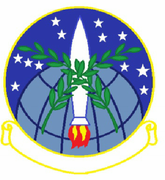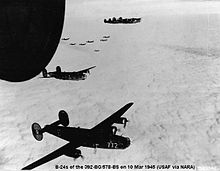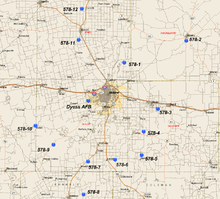| 578th Strategic Missile Squadron | |
|---|---|
 Convair SM-65F Atlas at Site 578-12 Corinth, Texas Convair SM-65F Atlas at Site 578-12 Corinth, Texas | |
| Active | 1943–1945; 1947–1949; 1961–1965 |
| Country | |
| Branch | |
| Type | Squadron |
| Role | Intercontinental ballistic missile |
| Motto(s) | Pax Per Potentem Latin Peace Through Power |
| Engagements | European Theater of Operations |
| Decorations | Distinguished Unit Citation |
| Insignia | |
| 578th Strategic Missile Squadron emblem |  |
| World War II fuselage code | EC |
| World War II group tail code | Circle D |
The 578th Strategic Missile Squadron is an inactive United States Air Force unit. It was last assigned to the 96th Strategic Aerospace Wing at Dyess Air Force Base, Texas, where it served from July 1961 until it was inactivated as part of the phaseout of the SM-65F Atlas intercontinental ballistic missile on 25 March 1965.
The squadron was first organized during World War II as the 578th Bombardment Squadron, a heavy bomber unit. After training with Consolidated B-24 Liberators in the United States, the unit deployed to the European Theater of Operations, where it participated in the strategic bombing campaign against Germany. The squadron was awarded a Distinguished Unit Citation for its actions in an attack against Gotha, Germany in 1944. It returned to the United States after V-E Day, but was inactivated in September 1945. From 1947 to 1949, the squadron was active in the reserve, but was apparently not fully manned or equipped with operational aircraft.
History
World War II
Organization and training
The squadron was first activated at Davis-Monthan Field, Arizona in January 1943 as the 578th Bombardment Squadron, one of the original four squadrons of the 392nd Bombardment Group. The squadron trained with Consolidated B-24 Liberators at bases in the southwestern United States, completing its training in July. On 18 July 1943, the squadron's ground echelon left its last training base, Alamogordo Army Air Field for the New York Port of Embarkation, sailing for the European Theater of Operations a week later, while the air echelon ferried their Liberators across the Atlantic.
Combat in the European Theater

The squadron arrived at its combat station, RAF Wendling on 1 August 1943 and flew its first combat mission on 9 September.
The ground echelon arrived in the United Kingdom on 30 July and arrived at RAF Wendling, the squadron's combat station, the following day. The air echelon had arrived at the station by 15 August. The squadron flew its first combat mission on 9 September. Most of the established B-24 units of VIII Bomber Command were deployed to reinforce efforts in the Mediterranean Theater of Operations when the squadron began operations, and during September and until the other Liberator units returned in early October, the squadron was primarily involved in flying decoy missions near the North Sea, while the command's main raids were being conducted by its Boeing B-17 Flying Fortresses. Until April 1945, the squadron was primarily engaged in the strategic bombing campaign against Germany. Strategic targets included an oil refinery at Geilenkirchen, a marshalling yard at Osnabruck, a railway viaduct at Bielefeld, steel plants at Braunschweig an armored vehicle factory at Kassel and gas works at Berlin.
The squadron participated in the heavy attacks against the German aircraft manufacturing industry during Big Week in late February 1944. During this campaign it earned a Distinguished Unit Citation for an attack on a component manufacturing plant for the Messerschmitt Me 210 at Gotha. The squadron formed part of the group leading the second wing in the attack. It began to experience heavy fighter opposition soon after crossing the coast in the Netherlands. Although the trailing elements of the first wing to attack had missed the target when a wounded lead bombardier collapsed and inadvertently toggled the plane's bombs, the 392d Group did not follow that formation, but attacked the Gotha factory with an extremely accurate bomb run with 98% of its bombs falling within 2000 feet of the aiming point. Despite losses, the plant was put out of commission for an estimated six to seven weeks.
The squadron was sometimes diverted from its strategic mission to perform air support and interdiction missions. In preparing for Operation Overlord, the invasion of Normandy, it participated in Operation Crossbow, attacking V-1 flying bomb and V-2 rocket launching sites, and airfields. On D-Day, it struck coastal defenses and choke points. It struck enemy positions opposing Operation Cobra, the breakout at Saint Lo in July 1944. During the Battle of the Bulge in December 1944 and January 1945, it bombed railroads, bridges and highways to break German lines of communication. It supported airborne attacks by dropping supplies, both near Arnhem in the Netherlands for Operation Market Garden in September 1944 and during Operation Varsity, the airborne assault across the Rhine in March 1945.
Return to the United States and inactivation
The squadron flew its last combat mission on 25 April 1945. Flooding in areas of the Netherlands not occupied by the Allies had reduced the Dutch population to near starvation. During the first week of May, the squadron flew missions dropping food for the population. The first squadron Liberators departed for the United States on 29 May 1945. Ground personnel sailed on the RMS Queen Mary on 15 June, arriving at the New York Port of Embarkation on 20 June. After leave, the squadron reassembled at Charleston Army Air Field, South Carolina, to perform airlift duties, but apparently was not fully manned or equipped before inactivating on 13 September 1945.
Air Force reserve
On 9 September 1947, the squadron was activated in the reserve under Air Defense Command (ADC) at Barksdale Field, Louisiana, where its training was supervised by the 174th AAF Base Unit (later the 2509th Air Force Reserve Training Center). It is not clear whether or not the squadron was fully staffed or equipped at this time. In 1948 Continental Air Command assumed responsibility for managing reserve and Air National Guard units from ADC.
The May 1949 Air Force Reserve program called for a new type of unit, the Corollary unit, which was a reserve unit integrated with an active duty unit. The plan called for corollary units at 107 locations. It was viewed as the best method to train reservists by mixing them with an existing regular unit to perform duties alongside the regular unit. The 47th Bombardment Wing had moved to Barksdale in 1948, and on 27 June 1949, the squadron became a light bomber squadron as a corollary of the 47th Wing, flying its Douglas B-26 Invaders. However, President Truman’s reduced 1949 defense budget required reductions in the number of units in the Air Force, and the 47th Wing was inactivated in October 1949. As a result, the 578th was also inactivated on 10 November 1949.
Intercontinental ballistic missile squadron
The squadron was redesignated the 578th Strategic Missile Squadron and organized in July 1961 at Dyess Air Force Base, Texas, where it was assigned to the 96th Bombardment Wing. The squadron was assigned twelve missiles, with twelve independent widely dispersed launch sites. The Atlas F used all inertial guidance and had more powerful engines and improved reentry vehicles than earlier models. The Atlas Fs were stored in a silo lift launcher. The missile was stored on its launcher in a hardened silo, but was lifted along with its launcher above ground before launch. The SM-65F was designed for long term storage of liquid fuel and shortened countdown
- Missile sites

Download coordinates as:
- 578–1 1.5 mi SE of Lake Fort Phantom Hill, Texas 32°36′09″N 099°38′59″W / 32.60250°N 99.64972°W / 32.60250; -99.64972
- 578–2 1.5 mi S of Albany, Texas 32°42′23″N 099°17′51″W / 32.70639°N 99.29750°W / 32.70639; -99.29750
- 578–3 2.5 mi SE of Clyde, Texas 32°22′54″N 099°27′37″W / 32.38167°N 99.46028°W / 32.38167; -99.46028
- 578–4 9.6 mi SSW of Clyde, Texas 32°16′25″N 099°32′28″W / 32.27361°N 99.54111°W / 32.27361; -99.54111
- 578–5 1.5 mi SE of Lake Coleman, Texas 32°09′42″N 099°33′10″W / 32.16167°N 99.55278°W / 32.16167; -99.55278
- 578–6 2.7 mi E of Lawn, Texas 32°08′25″N 099°42′12″W / 32.14028°N 99.70333°W / 32.14028; -99.70333
- 578–7 3.4 mi NE of Bradshaw, Texas 32°07′51″N 099°51′18″W / 32.13083°N 99.85500°W / 32.13083; -99.85500
- 578–8 4.9 mi ENE of Winters, Texas 31°58′24″N 099°52′48″W / 31.97333°N 99.88000°W / 31.97333; -99.88000
- 578–9 11.9 mi NW of Bradshaw, Texas 32°12′37″N 100°03′03″W / 32.21028°N 100.05083°W / 32.21028; -100.05083
- 578–10 13.1 mi S of Trent, Texas 32°18′05″N 100°09′11″W / 32.30139°N 100.15306°W / 32.30139; -100.15306
- 578–11 3.2 mi SSW of Anson, Texas 32°42′40″N 099°54′34″W / 32.71111°N 99.90944°W / 32.71111; -99.90944
- 578–12 7.52 mi N of Anson, Texas 32°51′37″N 099°53′29″W / 32.86028°N 99.89139°W / 32.86028; -99.89139
On 20 October 1962, after the detection of Soviet missiles in Cuba, Strategic Air Command (SAC) directed the squadron to reinstate all "degraded" missiles to alert status. SAC directed that this be done "as covertly as possible", for it was not until 22 October that President John F. Kennedy announced the presence of Soviet the missiles publicly. Atlas F missiles used for operational readiness training would be put on alert as soon as liquid oxygen became available, On 15 November, SAC directed that the squadron would be permitted to remove one of its missiles from alert to perform operational training and "shakedown" testing.
SAC also invoked the SAC/Air Force Systems Command (AFSC) Agreement for Emergency Combat Capability, which called for AFSC to turn over missiles still under its control to SAC to place them on alert. As a result an additional missile was turned over to the squadron to be placed on alert. On 15 November, SAC directed that the squadron would be permitted to remove one of its missiles from alert to perform operational training and "shakedown" testing. From 3 November the number of alert missiles was reduced until on 29 November the number was the same as before the crisis.
On 19 November 1964, Secretary of Defense Robert S. McNamara announced that, in addition to the phaseout of the SM-65D and SM-65E models, announced earlier, all SM-65F Atlas missiles would be phased out by the end of June 1965, in Project Added Effort. The first missile of the 578th Squadron was removed from alert in December to avoid the necessity for expensive repairs just before inactivation. The squadron was inactivated on 25 March 1965.
Lineage
- Constituted as the 578th Bombardment Squadron (Heavy) on 15 January 1943
- Activated on 26 January 1943
- Redesignated 578th Bombardment Squadron, Heavy on 20 August 1943
- Inactivated on 13 September 1945
- Redesignated 578th Bombardment Squadron, Very Heavy on 13 August 1947
- Activated in the reserve on 9 September 1947
- Redesignated 578th Bombardment Squadron, Light on 27 June 1949
- Inactivated on 10 November 1949
- Redesignated 578th Strategic Missile Squadron (ICBM-Atlas) and activated, on 25 January 1961 (not organized)
- Organized on 1 July 1961
- Inactivated on 25 March 1965
Assignments
- 392nd Bombardment Group, 26 January 1943 – 13 September 1945
- 392nd Bombardment Group, 9 September 1947 – 10 November 1949
- Strategic Air Command, 25 January 1961 (not organized)
- 96th Bombardment Wing (later 96th Strategic Aerospace Wing), 1 July 1961 – 25 March 1965
Stations
- Davis-Monthan Field, Arizona, 26 January 1943
- Biggs Field, Texas, 1 March 1943
- Alamogordo Army Air Field, New Mexico, 18 April – 18 July 1943
- RAF Wendling (AAF-118), England, 1 August 1943 – c. 7 June 1945
- Charleston Army Air Field, South Carolina, 23 June – 13 September 1945
- Barksdale Field (later Barksdale Air Force Base), Louisiana, 9 September 1947 – 10 November 1949
- Dyess Air Force Base, Texas, 1 July 1961 – 25 March 1965
Aircraft and missiles
- Consolidated B-24 Liberator, 1943–1945
- Convair SM-65F Atlas, 1961–1965
Awards and campaigns
| Award streamer | Award | Dates | Notes |
|---|---|---|---|
| Distinguished Unit Citation | 24 February 1944 | 578th Bombardment Squadron Gotha, Germany |
See also
References
Notes
- Explanatory notes
- In February 1963, Strategic Air Command bombardment wings that operated both bombers and missiles were redesignated strategic aerospace wings.
- Degraded sorties included missiles withdrawn from alert for modifications and those being used for operational readiness training. Kipp, et al., p. 62.
- Citations
- ^ Watkins, pp. 82-83
- ^ Maurer, Combat Squadrons, pp. 670-671
- ^ Maurer, Combat Units, pp. 279-281
- ^ Freeman, p. 256
- Freeman, pp. 90-91
- Freeman, pp. 110-111
- Freeman, p. 230
- See Mueller, p. 20 (reserve training center at Barksdale 1946-1949).
- See Maurer, Combat Squadrons, pp. 670-671 (no aircraft listed as assigned to the squadron during this period)
- "Abstract, Mission Project Closeup, Continental Air Command". Air Force History Index. 27 December 1961. Retrieved 24 March 2014.
- Cantwell, p. 73
- ^ Ravenstein, pp. 75-77
- Knaack, p. 25
- SAC Missile Chronology, p. 17
- SAC Missile Chronology, p. 24
- SAC Missile Chronology, p. 31
- Kipp, et al., pp. 62-63
- ^ Kipp, et al., p. 70
- Kipp, et al., pp. 64-65
- Kipp, et al., p. 66
- SAC Missile Chronology, p. 45
- ^ SAC Missile Chronology, p. 47
- ^ Lineage information, including assignments and aircraft, through May 1963 in Maurer, Combat Squadrons, pp. 670-671.
- Ravenstein, pp. 134-136
- Station number in Anderson, p. 20.
- Station information through May 1963 in Maurer, Combat Squadrons, pp. 670-671, except as noted.
- Mueller, p. 121
Bibliography
![]() This article incorporates public domain material from the Air Force Historical Research Agency
This article incorporates public domain material from the Air Force Historical Research Agency
- Anderson, Capt. Barry (1985). Army Air Forces Stations: A Guide to the Stations Where U.S. Army Air Forces Personnel Served in the United Kingdom During World War II (PDF). Maxwell AFB, AL: Research Division, USAF Historical Research Center. Retrieved 1 March 2021.
- Cantwell, Gerald T. (1997). Citizen Airmen: a History of the Air Force Reserve, 1946-1994 (PDF). Washington, D.C.: Air Force History and Museums Program. ISBN 0-16049-269-6. Retrieved 17 December 2016.
- Freeman, Roger A. (1970). The Mighty Eighth: Units, Men and Machines (A History of the US 8th Army Air Force). London, England, UK: Macdonald and Company. ISBN 978-0-87938-638-2.
- Knaack, Marcelle Size (1978). Encyclopedia of US Air Force Aircraft and Missile Systems (PDF). Vol. 2, Post-World War II Bombers 1945-1973. Washington, DC: Office of Air Force History. ISBN 0-912799-59-5. Retrieved 17 December 2016.
- Maurer, Maurer, ed. (1983) . Air Force Combat Units of World War II (PDF) (reprint ed.). Washington, DC: Office of Air Force History. ISBN 0-912799-02-1. LCCN 61060979.
- Maurer, Maurer, ed. (1982) . Combat Squadrons of the Air Force, World War II (PDF) (reprint ed.). Washington, DC: Office of Air Force History. ISBN 0-405-12194-6. LCCN 70605402. OCLC 72556.
- Mueller, Robert (1989). Air Force Bases, Vol. I, Active Air Force Bases Within the United States of America on 17 September 1982 (PDF). Washington, DC: Office of Air Force History. ISBN 0-912799-53-6. Retrieved 17 December 2016.
- Ravenstein, Charles A. (1984). Air Force Combat Wings, Lineage & Honors Histories 1947-1977 (PDF). Washington, DC: Office of Air Force History. ISBN 0-912799-12-9. Retrieved 17 December 2016.
- Watkins, Robert (2008). Battle Colors: Insignia and Markings of the Eighth Air Force In World War II. Vol. I (VIII) Bomber Command. Atglen, PA: Shiffer Publishing Ltd. ISBN 978-0-7643-1987-7.
- SAC Missile Chronology 1939-1988 (PDF). Offutt AFB, NE: Office of the Historian, Strategic Air Command. 1990. ISBN 978-1521159439. Retrieved 29 January 2018.
| United States Air Force Missile Units | |||||||||||||||||||||
|---|---|---|---|---|---|---|---|---|---|---|---|---|---|---|---|---|---|---|---|---|---|
| Strategic |
| ||||||||||||||||||||
| Tactical |
| ||||||||||||||||||||
| United States Air Force | |||||||||||
|---|---|---|---|---|---|---|---|---|---|---|---|
| Leadership |  | ||||||||||
| Structure |
| ||||||||||
| Personnel and training | |||||||||||
| Uniforms and equipment | |||||||||||
| History and traditions |
| ||||||||||
| |||||||||||||||||||||||||
| |||||||||||||||||||||||||
| |||||||||||||||||||||||||
| Airfields |  | ||||||||||||||
|---|---|---|---|---|---|---|---|---|---|---|---|---|---|---|---|
| Units |
| ||||||||||||||
| |||||||||||||||
